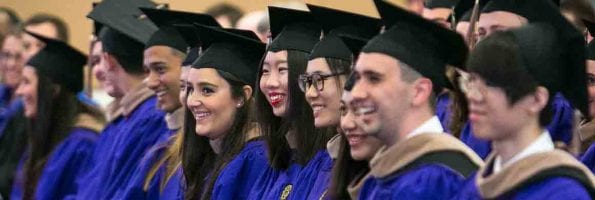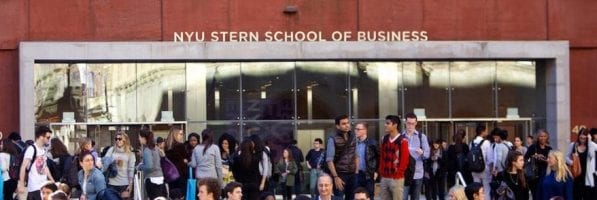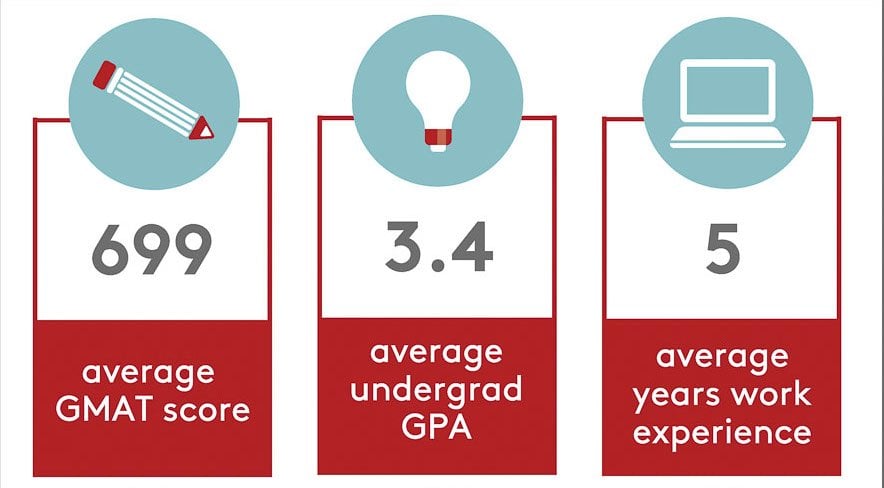Tech Interests and West Coast Jobs Spike in New Northwestern Kellogg Employment Report

Last week, Northwestern University’s Kellogg School of Management released its 2018 Employment Report revealing a record number of graduates going into the tech industry (28 percent) and more companies hiring Kellogg talent than ever before. Other highlights include a growing number of graduates headed to the West Coast for jobs (around one-third) and a steady employment rate with 94.6 percent of students receiving a job offer three months post-graduation—a slight increase from 94.1 percent last year.

Kellogg Job Offers and Salaries Remain Stable
Over the last two years, Northwestern Kellogg has witnessed strong and steady base salaries and job offers with little to no change. Although the number of MBA graduates heading into consulting decreased slightly this year (down to 30.1 percent from 32.9 percent), the median salary was $147,000 for both years. The technology industry had similar results though interest increased year-over-year (24.9 percent in 2017 compared to 28.3 percent in 2018). Median base salaries in technology stayed consistent with just a slight increase from $125,000 in 2017 to $130,000 in 2018.
As for graduates seeking employment, in both 2017 and 2018, around 82 percent of MBA students were looking for a job. Of those students, 94.1 percent received an job offer last year compared to 94.6 percent this year.
“We are thrilled to see the continued strong demand for Kellogg talent across a diverse range of industries and geographies,” Kellogg admissions says.
Kellogg Students Head to the West Coast & Work at a Range of Companies
One of the most notable differences this year was the number of MBA graduates heading to the West Coast. Thirty-three percent of students took a job in the West, the highest percentage ever. That change correlated to a decrease in interest in the Midwest down to 26.1 percent from 30.2 percent. However, more students took an international job compared to last year (12.8 percent in 2018 compared to 10.9 percent in 2017).
Another stand out in this year’s employment report was the growing breadth of companies hiring Kellogg talent. Last year, 207 companies were responsible for employing all 500-odd students. This year, 228 companies hired MBA graduates, “illustrating that Kellogg equips its graduates for jobs anywhere,” Kellogg admissions wrote.
As for the top companies hiring graduates, that prestige went to The Boston Consulting Group and McKinsey & Company, both of which hired 33 grads. Other top employers included Bain & Company (24), Amazon (21), and Deloitte Consulting LLP (12).
This article has been edited and republished with permissions from its original source on Clear Admit.
What Are the 5 Most Common MBA Interview Questions?

To get into an MBA program, you’ll first have to make it through the interview process. Depending on where you apply, you could be asked a range of different questions, many of which are specific to the school. Unfortunately, this can make it difficult to prepare for success, especially if you’re applying to more than one school at a time.
To help you prepare for your MBA interview, we’ve gathered together the five most common MBA interview questions, along with advice for answering each question. But first, we need to figure out what questions you’re most likely to run into.

Determining the Five Most Common Interview Questions
In a recent podcast on Clear Admit, Alex Brown, who wrote Becoming a Clear Admit: The Definitive Guide to MBA Admissions, tackled some of the most common MBA interview questions faced by current applicants. He unpacked interview questions such as, “Walk me through your résumé” as well as “Give us an example of a time you took a leadership role.”
To get a full idea of the most common interview questions, we took a look at the top ten schools as outlined by the U.S. News & World Report to figure out which questions were asked by the most schools. We looked at:
- UC Berkeley Haas
- University of Michigan Ross
- Northwestern Kellogg
- MIT Sloan
- Stanford Graduate
- The Wharton School
- Chicago Booth
- Harvard Business School
- Columbia University
- Dartmouth Tuck
At each of these schools, there were a few common denominators when it came to questions asked. Here’s what we found:
1. Why did you choose this school/program?
Almost every school, except MIT Sloan and Harvard Business School, wants to know why you’re interested in their specific program. After all, admissions teams know that you’re interviewing at more than one school and they want to know that you’ve done your research and chose schools that were a good choice for you personally. They don’t want to necessarily know that you know the history or prestige of their school or program, they want to know how their program aligns with your goals and interests and how it makes practical sense for you.
When answering this question, you want to try and be as specific as possible when it comes to “why” this program. Be sure to know which clubs, classes, centers, professors, case studies, alumni, or events fit into your MBA goals. This is your best opportunity to demonstrate your research and to show the admissions committee doesn’t question why you chose them, and that you’ve taken the time to imagine what it’s like to attend their school.
2. Why are you pursuing an MBA now?
You can go back to school for your MBA at any time, but why are you interested in going back now? That’s what every school wanted to know except for Wharton, HBS, and Columbia. The goal with this question is to figure out how an MBA fits in with your current goals for your career and objectives.
During this question, you want to talk about your future career plans and why your situation in life is leading you to make a move to the MBA now. You’ll want to discuss your motivation for choosing the MBA now and how the MBA will help your long-term interests be accomplished. Make sure your explanation plots out a path where the MBA is vital to reaching your goals.
3. Walk me through your résumé.
All but four schools on our list asked students to walk them through their resume. Often, this is the first question that you may be asked in your interview. The goal of this question is to allow you to give a summary of your experience to date. This gives the interviewer some groundwork that they can build upon for the rest of the interview. So, how you answer this question is vitally important.
This question might appear very simple at first glance, but it can have a lot of little landmines that you’ll want to avoid. A good approach to this question is to think of it as your resume executive summary but in verbal terms. The interviewer is looking for key descriptive terms that define who you are. This is your opportunity to weave in some strengths, passions, and interests.
We suggest coming up with a two- to three-minute verbal version of your resume that focuses on highlights in your career. Make sure you focus on “why” you made certain career choices to better explain your path and then highlight the outcomes of those choices.
4. Tell me about a time you demonstrated leadership. What did you learn from it?
This can be a tricky question, but it’s definitely one that you could come across since all but four schools were reported as asking it. The goal here is to demonstrate that you’ve had some experience in a leadership role, even if it’s not traditional. During this question, you can speak about any influence you may have had over your peers—outside of traditional hierarchy—or leadership skills you may have gained during a project.
The key is to prepare three to four anecdotes that you can draw from to highlight such things as your leadership style and skills. In particular, make sure you can talk about key leadership skills such as vision, communication, teamwork, and so forth. And if you can, make sure you can quantify the outcomes of your experience.
5. Are there any questions you’d like to ask the interviewer?
At all but two of the schools—Harvard and Dartmouth Tuck—interviewees were asked to finish out the interview with their own questions. While this might appear to be a simple question at first, it is vital that you get it right. No admissions committee wants you to be a passive candidate, and this is your chance to demonstrate that you are thoughtful, prepared, and interested.
The key here is not to be generic and only ask questions like, “Why do you love X school?” Instead, you want to ask questions that are specific to your goals. For example, you might ask, “What other resources does the school offer for this industry?”
In the end, whether you’ve already been invited to a few interviews or you’re still waiting to hear back, it’s important to get prepared as quickly as possible. By practicing answers to some of these common questions, you can ensure that your interviews go off without a hitch.
NYU Employment Report Reveals Employment, Salary Jump

The NYU Stern School of Business released its 2018 MBA Employment Report at the end of last month, revealing that more graduates in the Class of 2018 had accepted full-time job offers three months after graduation than anytime in the past five years. Not only that, many recent grads reported a large jump in salary and bonuses. There are just a few of the highlights from this year’s employment report, which also Amazon topping the this of MBA employers for the second year in a row.
NYU Employment Offers and Salaries Increase
This year, 93.7 percent of MBA graduates from Stern had accepted full-time job offers three months out from graduation. This was up from 91 percent last year, and higher than every year since 2013. As for compensation, average base salary jumped 6.5 percent year over year, to $129,059. Average signing bonus, meanwhile, increased 7.5 percent, to $35,637.
“We begin working hand-in-hand with our MBA students on the recruitment process before they even arrive on campus for their first semester,” says Beth Briggs, Stern Assistant Dean of Career Services. “Our early and continuous engagement, coupled with the quality of our students and a strong employment market in New York City, has led to great results across a variety of career paths. For Stern’s MBA class, the percentage of graduates who accepted job offers within three months of graduation is the highest in five years. Average salaries, average signing bonuses and the number of students reporting signing bonuses have also increased over last year.”
Consulting and Investment Banking Lead Stern Industries
When it comes to where Stern graduates work, the data remains consistent. Consulting and investment banking are the two most popular industries, luring 28.4 percent and 26.2 percent of the class, respectively. This represents a slight increase for both industries over last year. In 2017, consulting drew 26 percent and investing drew 23 percent. Technology and telecommunications stayed steady at 16.5 percent this year, on par with 2017. The only other notable changes in terms of industry appeal were a small dip in consumer packaged goods (falling to 5 percent, from 7 percent last year) and a slight increase in law (rising to 4 percent, from 2 percent).
“While the top three industries employing Stern students are consulting, investment banking, and tech, graduates are pursuing roles in a range of diverse areas including growing industries like fintech,” Briggs explains.

Amazon Hires Most Stern MBA Graduates
Amazon took the top spot for the second consecutive year as the most prolific hiring company of NYU Stern grads. Other top employers of graduates from the Class of 2018 included Credit Suisse, McKinsey & Company, J.P. Morgan, IBM, and Bain & Company. About 77.6 percent of grads accepted jobs in the Northeastern U.S., and 13.2 percent went West.
The majority of students (49.7 percent) received offers of employment from the companies where they completed their summer internships. Of those who chose not to accept a job where they interned, 20.1 percent received an offer from an on-campus scheduled interview. In addition, about 9.7 percent found their job through Stern job postings. The rest of the class found jobs through personal contacts (6.3 percent), external job boards (4.7 percent), or alumni (3.1 percent).
You can view the complete NYU Stern 2018 Employment Report here.
This article has been edited and republished with permissions from Clear Admit.
Chicago Booth, Northwestern Kellogg Top Economist 2018 Rankings

The newest Economist best MBA rankings for full-time programs is officially out, with two Chicago schools topping the list.
Applications Down 4.5 Percent at HBS, But Applicant Quality Remains High

The release of the Harvard Business School (HBS) Class of 2020 profile statistics last week revealed that the Boston school—like many of its U.S. peers—saw a decrease in overall application volume, but median GMAT score and GPA remained unchanged from the prior year at 730 and 3.71 respectively. The admit rate, 11 percent, was also unchanged year over year. So though he was working from a smaller pool of 9,886 applicants (down from 10,351 last year), Managing Director of Admissions and Financial Aid Chad Losee did not sacrifice on quality.
Harvard Business School Application Slips for Class of 2020
HBS is one of many leading U.S. business schools to see application volume drop off in this most recent application cycle. A strong economy paired with concerns among international applicants about potential student and work visa challenges made for even more dramatic declines at schools like UNC Kenan-Flagler and Georgetown’s McDonough School, which reported double-digit drops of 18.3 and 16.2 percent respectively. Yield at HBS–which is to say the percentage of admitted students who chose to enroll–slipped from 91 to 90 percent. Still, HBS remains far and away the leader in this statistic.

Applications are down 4.5 percent at HBS, but declines across other U.S. MBA programs was much more apparent.
At HBS, the 4.5 percent application volume decline was spread between both international and domestic applicants. International students make up slightly more of the HBS class this year, 37 percent compared to 35 percent last year. They hail from 69 countries as compared to 70 for the Class of 2019.
Another interesting development is the increase in GRE takers among admitted students. A record-setting 15 percent of the incoming class got there on the strength of their GRE scores, up from 12 percent last year. It’s only in the past couple of years that schools have begun to disclose the percentages of students who submit GRE scores in lieu of GMAT scores, which used to be the gold standard. But at HBS and elsewhere, a growing number of applicants seem to be taking schools at their word that they are indeed test agnostic.
There were not a lot of major shifts elsewhere in the statistics for the newest HBS class. The percentage of women is down by one point, slipping from 42 to 41 percent. U.S. ethnic minorities remained constant year over year at 26 percent of the class. The average age also remains unchanged at 27.
Applicants from Private Equity, Tech, Increase
In terms of prior work experience, there were again few shifts from the prior year. Slightly more students came in from private equity/venture capital (16 percent, compared to 15 percent last year), tech (also 16 percent, up from 15), and government/non-profit (7 to 8 percent). These upticks correlate with small declines in students from industrial/heavy manufacturing and other services. Military veterans make up 5 percent of the Class of 2020, on par with the Class of 2019.
And in terms of what students in this year’s entering class studied as undergraduates, again HBS showed little fluctuation. Economics/business majors make up the largest portion—46 percent, up from 45 percent last year. STEM undergrads also increased one percentage point, from 36 to 37 percent. Humanities/social science undergraduates made up just 17 percent of the class, down from 19 percent last year.
To view HBS’s complete Class of 2020 profile, click here.
This article has been edited and republished with permissions from our sister site, Clear Admit.
New Johnson Cornell MBA Class of 2020 Features More Women and URMs

The Cornell MBA Class of 2020 kicked off the fall semester in style earlier this month at the Johnson Graduate School of Management. To formally welcome the new recruits to the Cornell community, Johnson Business Feed revealed a comprehensive class profile, shedding light on the students who make up the incoming class.
The Johnson Cornell MBA Class of 2020

There are 280 students in the incoming students (up just slightly from last year’s 277), and they boast an average GMAT score of 699 and an average undergrad GPA of 3.4. The figures are pretty similar to the Class of 2019, where average GMAT score was 700 and average GPA was 3.36. Average work experience remains constant year over year, with incoming students bringing five years’ experience in the workforce to bear on their business school journey.
Admissions Director Judi Byers and her team have been working hard to recruit more women to Johnson, and their efforts are paying off. Women make up a full third—33 percent—of this year’s incoming class, a six-point increase over last year. The percentage of underrepresented minorities (URMs) in the Class of 2020 also grew from 12 percent last year to 15 percent with this new class. In total, U.S. minorities make up 32 percent of the new class. That figure includes Asian American, African American, Native American, and Hispanic American students.
International students, though, dipped. International students made up 34 percent of last year’s incoming class, but this year they account for only 27 percent. Johnson, like many of its peer schools, experienced a drop-off in international application volume amid widespread concerns around possible U.S. immigration and work visa restrictions. Still, they will bring perspectives from 40 different countries to the Johnson classroom. That’s up from 38 countries represented in the second-year class. There are also fewer military veterans in this year’s class—7 percent as compared to 11 percent for the Class of 2019.
In terms of undergraduate majors, former business students coming in first, making up 29 percent of the class. Social science majors make up the second largest group at 21 percent. This was followed closely by engineers, who comprise another 20 percent of the class. Humanities majors are in the minority: They represent just 10 percent of the Class of 2020.
As for previous work experience, the vast majority of the incoming class—44 percent—falls into the category of “other.” According to Johnson, this includes students who have worked in the real estate, energy, nonprofit, and transportation industries, among others. Roughly a quarter of the class—23 percent—come from finance, and another 17 percent are former consultants.
On Instagram post, Byers shares that the Class of 2020 got into the spirit of things during pre-term week, adding to the school’s shared wall of values and expectations. Community, impact, collaboration, excellence, and teamwork were among those she highlights.
Click here to view the complete Cornell MBA Class of 2020 profile.
